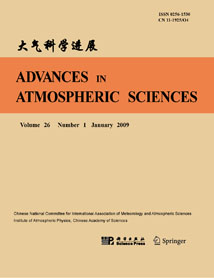| [1] |
Pengfei WANG,
2017: A High-Order Spatiotemporal Precision-Matching Taylor-Li Scheme for Time-Dependent Problems, ADVANCES IN ATMOSPHERIC SCIENCES, 34, 1461-1471.
doi: 10.1007/s00376-017-7018-1
|
| [2] |
Ji Zhengang, Chao Jiping,
1987: TELECONNECTIONS OF THE SEA SURFACE TEMPERATURE IN THE INDIAN OCEAN WTTH SEA SURFACE TEMPERATURE IN THE EASTERN EQUATORIAL PACIFIC, AND WITH THE 500 hPa GEOPOTENTIAL HEIGHT FIELD IN THE NORTHERN HEMISPHERE, ADVANCES IN ATMOSPHERIC SCIENCES, 4, 343-348.
doi: 10.1007/BF02663604
|
| [3] |
S.K. Sinha, S. Rajamani,
1995: Multivariate Objective Analysis of Wind and Height Fields in the Tropics, ADVANCES IN ATMOSPHERIC SCIENCES, 12, 233-244.
doi: 10.1007/BF02656836
|
| [4] |
Ji Zhongzhen, Wang Bin,
1997: Multispectrum Method and the Computation of Vapor Equation, ADVANCES IN ATMOSPHERIC SCIENCES, 14, 563-568.
doi: 10.1007/s00376-997-0074-1
|
| [5] |
Baofeng JIAO, Lingkun RAN, Na LI, Ren CAI, Tao QU, Yushu ZHOU,
2023: Comparative Analysis of the Generalized Omega Equation and Generalized Vertical Motion Equation, ADVANCES IN ATMOSPHERIC SCIENCES, 40, 856-873.
doi: 10.1007/s00376-022-1435-5
|
| [6] |
Shenming FU, Jie CAO, Xingwen JIANG, Jianhua SUN,
2017: On the Variation of Divergent Flow: An Eddy-flux Form Equation Based on the Quasi-geostrophic Balance and Its Application, ADVANCES IN ATMOSPHERIC SCIENCES, 34, 599-612.
doi: 10.1007/s00376-016-6212-x
|
| [7] |
li liu, Xueen Chen,
2024: A Spatial-dependent Nudging Method and Its Application to Global Tide Assimilation, ADVANCES IN ATMOSPHERIC SCIENCES.
doi: 10.1007/s00376-024-4062-5
|
| [8] |
Chen Wanlong, Chu Pao-Shin,
1990: On the Couplings between Chebyshev Coefficients as Derived from the Monthly Mean Geopotential Fields at 500 hPa over East Asia and the Southern Oscillation, ADVANCES IN ATMOSPHERIC SCIENCES, 7, 347-353.
doi: 10.1007/BF03179766
|
| [9] |
ZHU Congwen, Chung-Kyu PARK, Woo-Sung LEE, Won-Tae YUN,
2008: Statistical Downscaling for Multi-Model Ensemble Prediction of Summer Monsoon Rainfall in the Asia-Pacific Region Using Geopotential Height Field, ADVANCES IN ATMOSPHERIC SCIENCES, 25, 867-884.
doi: 10.1007/s00376-008-0867-x
|
| [10] |
Peng Yongqing, Yan Shaojin, Wang Tongmei,
1995: A Nonlinear Time-lag Differential Equation Model for Predicting Monthly Precipitation, ADVANCES IN ATMOSPHERIC SCIENCES, 12, 319-324.
doi: 10.1007/BF02656980
|
| [11] |
Zhou Jiabin,
1985: A NEW TYPE OF TIME-SERIES-FORECASTING METHOD, ADVANCES IN ATMOSPHERIC SCIENCES, 2, 385-401.
doi: 10.1007/BF02677255
|
| [12] |
Xiaojuan SUN, Siyan LI, Julian X. L WANG, Panxing WANG, Dong GUO,
2022: A New Method of Significance Testing for Correlation-Coefficient Fields and Its Application, ADVANCES IN ATMOSPHERIC SCIENCES, 39, 529-535.
doi: 10.1007/s00376-021-1196-6
|
| [13] |
YUAN Zhuojian, JIAN Maoqiu,
2003: A Linear Diagnostic Equation for the Nonhydrostatic Vertical Motion W in Severe Storms, ADVANCES IN ATMOSPHERIC SCIENCES, 20, 875-881.
doi: 10.1007/BF02915511
|
| [14] |
WANG Hesong, JIA Gensuo,
2013: Regional Estimates of Evapotranspiration over Northern China Using a Remote-sensing-based Triangle Interpolation Method, ADVANCES IN ATMOSPHERIC SCIENCES, 30, 1479-1490.
doi: 10.1007/s00376-013-2294-x
|
| [15] |
S. K. Sinha, D. R. Talwalkar, S. Rajamani,
1987: ON SOME ASPECTS OF OBJECTIVE ANALYSIS OF HUMI-DITY OVER INDIAN REGION BY THE OPTIMUM INTERPOLATION METHOD, ADVANCES IN ATMOSPHERIC SCIENCES, 4, 332-342.
doi: 10.1007/BF02663603
|
| [16] |
S.K. Sinha, D.R. Talwalkar, S.G. Narkhedkar, S. Rajamani,
1989: A Scheme for Objective Analysis of Wind Field Incorporating Multi-Weighting Functions in the Optimum Interpolation Method, ADVANCES IN ATMOSPHERIC SCIENCES, 6, 435-446.
doi: 10.1007/BF03342547
|
| [17] |
Da-Lin ZHANG, Xiaoxue WANG,
2003: Dependence of Hurricane Intensity and Structures on Vertical Resolution and Time-Step Size, ADVANCES IN ATMOSPHERIC SCIENCES, 20, 711-725.
doi: 10.1007/BF02915397
|
| [18] |
Yi Zengxin, T. Warn,
1987: A NUMERICAL METHOD FOR SOLVING THE EVOLUTION EQUATION OF SOLITARY ROSSBY WAVES ON A WEAK SHEAR, ADVANCES IN ATMOSPHERIC SCIENCES, 4, 43-54.
doi: 10.1007/BF02656660
|
| [19] |
GUO Yanjun, DING Yihui,
2011: Impacts of Reference Time Series on the Homogenization of Radiosonde Temperature, ADVANCES IN ATMOSPHERIC SCIENCES, 28, 1011-1022.
doi: 10.1007/s00376-010-9211-3
|
| [20] |
Daosheng XU, Jeremy Cheuk-Hin LEUNG, Banglin ZHANG,
2023: A Time Neighborhood Method for the Verification of Landfalling Typhoon Track Forecast, ADVANCES IN ATMOSPHERIC SCIENCES, 40, 273-284.
doi: 10.1007/s00376-022-1398-6
|















 AAS Website
AAS Website 
 AAS WeChat
AAS WeChat 
 DownLoad:
DownLoad: